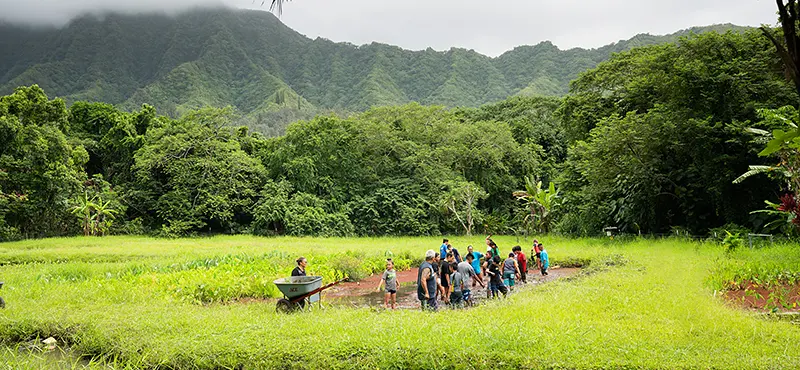The first trustees
 Charles Reed Bishop (1884-1898)
Charles Reed Bishop (1884-1898)
Charles R. Bishop was born at Glens Falls, New York, on January 25, 1822. He was an orphan in his early years and went to live with his grandparents. At the age of fifteen, he took a position in a country store in a neighboring village. The next two years. he spent working on a farm and during the part of the time as a worker in a store in a larger town not far away. When he was 24 years old, he sailed from Newburyport, Massachusetts, around Cape Horn on the way to Oregon. The vessel made a stop in Honolulu. The trip having been an exceedingly stormy one, Mr. Bishop decided to remain in Honolulu for a period of months before proceeding on to Oregon. He made his way slowly and after some years formed a banking institution with Mr. W. A. Aldrich as his partner. This later became the bank of Bishop. Through his own character and institution, Mr. Bishop did much to aid the developing economic institutions of Hawaii. He had firm faith in the work that was being done in these islands and on number of occasions, he stood firmly when disaster of one kind or another threatened that work. In 1850, he married Bernice Pauahi Paki. From that time on, he played a very active part in the government of the islands. Mrs. Bishop died in 1884, leaving her estate for the establishment of schools for the advancement of education among the children of Hawaiian ancestry. Mr. Bishop became one of the first trustees of that estate and remained so until after he had moved to California where he made his home during the latter years of his life. The Friend, June 1948, pg.12)
He became a naturalized citizen of the Kingdom of Hawai'i in 1849 and was appointed Collector of Customs. The Bishops were dedicated to education. He provided leadership to the Board of Education under Kings Kamehameha V, Lunalilo and Kalakaua and it was his wife who founded the Kamehameha Schools. In addition to being a close friend and confidant of Hawaiian royalty, Bishop held many other court-appointed positions. After his wife's death, Bishop founded the Bernice P. Bishop Museum in her memory. The museum now has the largest collection of Hawaiian artifacts and is a world renowned museum and a mecca of knowledge for Polynesian history and antiquities.
 Charles Montague Cooke (1884-1897)
Charles Montague Cooke (1884-1897)
Mr. Cooke was born in Honolulu on May 16, 1849, the second son of Amos Star Cooke, who was a member of the Eighth Company of missionaries. After completing his education, Mr. C. M. Cooke joined the firm of Castle & Cooke in Honolulu and worked there for a period of years. He then united with Mr. Robert Lewers to establish the firm of Lewers & Cooke. After years of active service to the territory both in business and in political life, Mr. Cooke left Honolulu in 1894 with the intention of making his home in California. However, four years later he returned to become President of the Bank of Hawaii and also of C. Brewer & Company. Mr. Cooke took great interest in some of the developing agricultural enterprises of Hawaii and lent his every effort both to their establishment and to their successful development. The Cooke library at Punahou School and the Aquarium building at Waikiki beach are tributes to his generosity and widespread interests. He died in 1909. The Friend, June 1948, pg.13)
 Samuel Mills Damon (1884-1897,1898-1916)
Samuel Mills Damon (1884-1897,1898-1916)
Mr. M. Damon was born in Honolulu on March 13, 1845. He was the son of the Reverend S. C. Damon, who for many years was the pastor of the Bethel Church and was the founder of the FRIEND magazine. Mr. S. M. Damon showed rare ability in the field of business and finance and succeeded Mr. Charles R. Bishop when the latter left the islands for San Francisco but Mr. Damon is equally well known for his participation in public affairs. He was a member of the Privy Council of the Hawaiian Kingdom for a number of years and held important posts in government almost throughout his life. He represented the Hawaiian Kingdom at the court of London for the diamond jubilee of Queen Victoria in 1897 and two years later, he went to Italy as a representative of his government. Mr. Damon died in 1924. The Friend, June 1948, pg.12)
 Charles McEwen Hyde (1884-1899)
Charles McEwen Hyde (1884-1899)
Mr. Hyde was born in New York City in 1832. He received a thorough University and Theological training and then occupied pasturage back in the New England States. In 1876, he was asked by the American Board to come to the Hawaiian Islands to assist in the training of pastors of Hawaiian ancestry. He arrived in Honolulu in the following year. He was placed in charge of the Training School which had been operated by the mission and reorganized it under the name of North Pacific Institute. He directed this institution until the time of his death. However his rare abilities and excellent training made him one of the outstanding leaders in the missionary enterprise while he was here. He was an excellent administrator and an outstanding educator and in these two activities, he was much in demand. The summer of 1899 his health began to fail and after a brief trip to see his son in Massachusetts he returned to Honolulu where he died on October 13th. The Friend, June 1948, pg.12)
 William Owen Smith (1884-1886, 1897-1929)
William Owen Smith (1884-1886, 1897-1929)
Mr. Smith was the son of Dr. James W. Smith and was born in Koloa, Kauai. For a period of time, he worked in the sugar industry and served as sheriff on the island of Kauai. He then entered the office of Judge A. S. Hartwell and there read law. He was admitted to practice in 1875. From then on he filled an important place in the life of the territory in the field of law. He occupied many public offices such as that of the Attorney General, President of the Board of Health, a member of the legislature, and he was very closely identified with the affairs of the Hawaiian Kingdom during its closing years. He was one of the leaders in the movement which changed the status of Hawaii from a kingdom to that of a territory of the United States. He was the one who represented Hawaii before the committee of the United States Congress which considered the Organic Act of our territory. The Friend, June 1948, pg.13)















